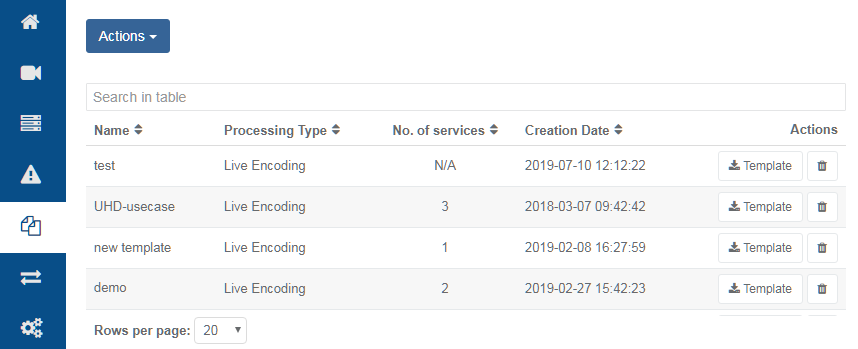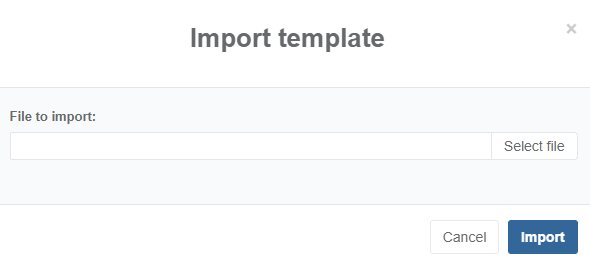Manage templates
Templates are a set of parameters saved from an existing service configuration. This allows you to easily create new services that share the same settings.
You can create a template from an existing service configuration. The template is stored separately from the services.
Service templates include:
- Constants: all parameters that are common to all services sharing the template.
- Variables: parameters that depend on the service.
Selecting a template when creating a service replaces the default settings with the template presets. It still requires entering missing variable information identified in the user interface.
You can export variables to a CSV file for mass configuration.
Changing a template requires:
- Changing the template name.
- Version management is implemented (can embed versions).
Display templates
-
Click Templates from the left-side menu panel. If any, the available templates display in a table.

-
You can edit the number of rows displayed or use the search bar to filter the display.
Template parameters
| Column | Description |
|---|---|
| Name | Unique template name. |
| Processing Type | The service processing type. |
| No. of Services | Total number of services in your solution that are configured with the template. |
| Creation date | Template creation date (YYYY-MM-DD) and time (HH:MM:SS). |
| Actions | Export or delete. |
Create a template
To create a template, follow these steps:
-
Click and ensure that service parameters comply to expected configurations.
-
From the Services page, Click the 3-vertical dots icon then select Save as template.
-
Enter a unique Name and click Create.
Delete a template
Deleting a template has no impact on services created from that template.
To delete a template, follow these steps:
-
Display templates.
-
Click in the Actions column.
-
Confirm the action if prompted. The template is deleted and no longer displays in the table.
Create a new service from a template
When creating a new service, you can apply a template to automatically insert existing service configuration parameters.
You can edit any service settings, even if the service was created from a template.
Before you start, ensure a template already exists.
-
Click Services in the left-side menu panel.
-
Click Add service then select a service type from the list to display options.
-
Next to the Template parameter, select a template from the list of available templates.
-
Click Save. The service is created and displays in the Services grid.
-
Click to edit or to check the service configuration for accuracy.
Export a template
You can export templates to share them on different MediaKind Controllers.
-
Click
 to export. The file is downloaded in relation to your web browser download settings.
to export. The file is downloaded in relation to your web browser download settings.
The download date is in the downloaded file name. The date is in the following format: MM/DD/YYYY.
Export a template variables form
You can download template variables to use in massive configurations.
-
Click
 to export. A .csv file is downloaded in relation to your web browser download settings.
to export. A .csv file is downloaded in relation to your web browser download settings.
The download date is in the downloaded file name. The date is in the following format: MM/DD/YYYY.
Import a template
Before you start, ensure a template file exported from a different Controller environment is available.
-
Click Actions.
-
Select Import template.

-
Click Select file to choose a file, then click Import.

The template is uploaded and available in the Templates table.
- Template names must be unique.
- You are unable to import a template if the template with the same name already exists on this Controller.